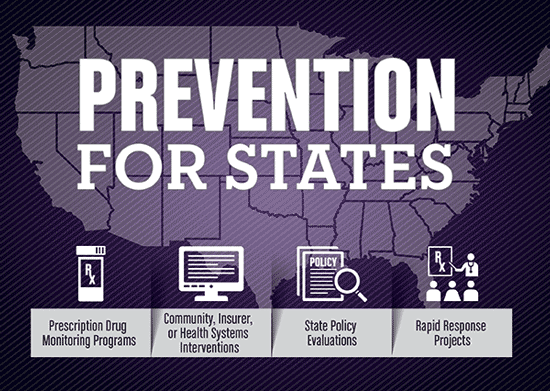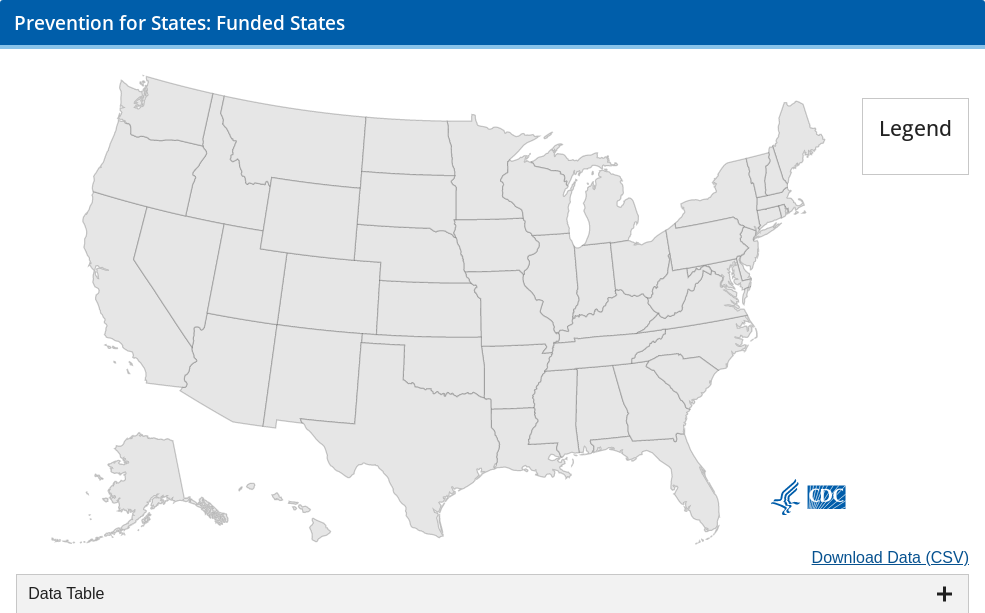Prevention for States
Archived Content: This Page Is No Longer Being Updated
This page is archived for historical purposes and is no longer being maintained or updated.
Please see Overdose Data to Action (OD2A) for the most recent information on CDC-funded programs.

Prescription Drug Overdose: Prevention for States is a program that helps states combat the ongoing prescription drug overdose epidemic. The purpose of Prevention for States is to provide state health departments with resources and support needed to advance interventions for preventing prescription drug overdoses.
Funded States
CDC funds 29 states through the Prevention for States program (see map): Arizona, California, Colorado, Connecticut, Delaware, Illinois, Indiana, Kentucky, Maine, Maryland, Massachusetts, Nebraska, Nevada, New Mexico, New York, North Carolina, Ohio, Oklahoma, Oregon, Pennsylvania, Rhode Island, South Carolina, Tennessee, Utah, Vermont, Virginia, Washington, West Virginia, and Wisconsin.
- September 2015: 16 states were funded $14.4 million and began executing and evaluating prevention strategies to improve safe prescribing practices and prevent prescription drug overuse, misuse, abuse, and overdose.
- March 2016: 13 more states were funded for a total of $10.8 million per year.
- September 2016: 14 states were awarded a competitive supplement totaling $11.4 million.
- September 2017: 8 additional states were funded for the competitive supplement for $4.8 million; also 27 of the 29 states were funded with a non-competitive supplement for $19.3 million.
Priority Strategies and Activities
Through 2019, CDC plans to give selected states annual awards between $750,000 and $1 million to advance prevention in four key areas. Awarded states are collaborating with key partners to maximize efforts and address issues that impact prescribing and drug overdoses. Examples of states’ activities include:
Maximizing PDMPs
- Moving toward universal registration and use
- Making PDMPs easier to use and access
- Making PDMP data more timely
- Expanding and improving proactive PDMP reporting to identify and address inappropriate prescribing patterns
- Using PDMP data to better understand the nature of the prescription drug overdose epidemic
Community or Insurer/Health Systems Interventions
- Providing technical assistance to high-burden communities and counties
- Improving opioid prescribing interventions for insurers and health systems
- Enhancing use of evidence-based opioid prescribing guidelines
Policy Evaluations
- Evaluating interventions to better understand what works to prevent prescription drug overdoses
Rapid Response Project
- Implementing a project to advance an innovative prevention approach and respond to new and emerging crises and opportunities
Prescription Drug Overdose: Boost for State Prevention (Prevention Boost) was an initiative where CDC’s Injury Center equipped five state health departments—Kentucky, Oklahoma, Tennessee, Utah, and West Virginia—with resources and scientific assistance to prevent prescription drug overdoses. Funding was provided to advance three key areas: (1) maximizing the use of PDMPs; (2) improving public insurance mechanisms to protect patients; and (3) evaluating policies to identify prevention that works. The current PDO Prevention for States program was originally created to scale up this work.
Impact
The Prevention for States program includes evaluation of awarded states’ program activities to monitor performance, demonstrate effectiveness, and capture success stories. Results and project successes will determine the impact of this program and inform future state and national efforts in preventing prescription drug overdoses.


